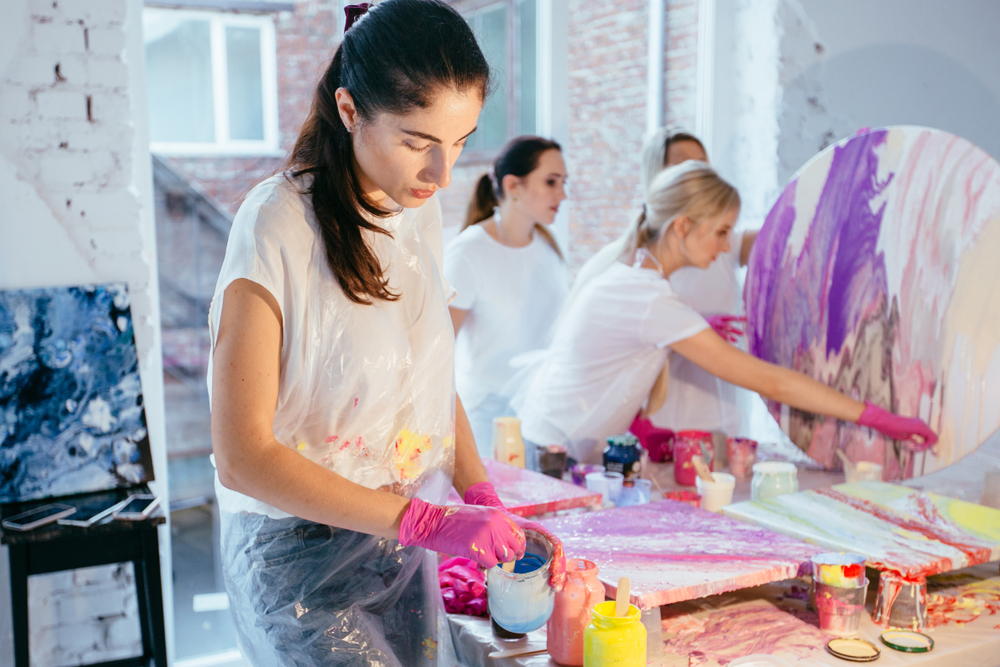Adolescence is a time of rapid change—socially, emotionally, and physically. Stressors can include academic pressures, identity exploration, family dynamics, peer relationships, and more. Traditional talk therapy doesn’t always feel accessible for teens who are still learning how to name and process emotions.
Art therapy offers an alternative path. Through painting, drawing, sculpture, or other creative techniques, teens can express themselves without needing to explain everything verbally. Art becomes a language of its own, helping therapists and teens explore deeper emotional layers with less pressure.
Common Art Therapy Techniques for Teen Stress Relief
Art therapy is highly individualized, but here are a few techniques that often support stress management in adolescents:
- Mood Collages: Teens gather images, words, or colors that reflect how they’re feeling, offering insight into internal experiences.
- Visual Journaling: A combination of images and words used to track moods, thoughts, or progress over time.
- Mask Making: Helps explore inner vs. outer emotions—what we show vs. what we feel.
- Clay or Sculpture Projects: Encourages hands-on creation and can be grounding for anxious energy.
- Abstract Painting: Offers a nonjudgmental outlet for emotion when words fall short.
Each of these techniques helps teens explore their inner world in a way that feels natural and non-threatening.
The Mental Health Benefits of Creative Expression
Engaging in art therapy can help reduce stress by activating different parts of the brain than verbal processing. It encourages a sense of play, creativity, and curiosity—often lost during periods of depression or anxiety. Some of the key mental health benefits include:
- Improved emotion regulation
- Greater self-awareness
- Enhanced problem-solving and decision-making
- Increased self-esteem and confidence
- Reduced anxiety and tension
Importantly, teens don’t need to be “good at art” to benefit. The focus is on process over product.
Helping Teens Reconnect With Themselves Through Art
Creative expression offers more than just stress relief—it can help teens reconnect with parts of themselves that feel lost or hidden. When stress builds up, it often disconnects teens from their natural sense of play, identity, and emotional rhythm. Art therapy invites them to rediscover who they are without judgment or pressure.
Whether it’s through color, texture, or movement, creating art helps teens feel more grounded. It gives them a sense of agency and ownership over their emotional experience, which can be particularly powerful during a time in life when so much feels out of their control.
Building a Therapeutic Relationship Through Art
Art therapy isn’t just about the art—it’s also about connection. Through the process of creating and reflecting, a trained therapist builds trust and rapport with the teen. This relational safety is essential for therapy to be effective.
Teens may not open up right away in conversation, but through their artwork, they often share more than they realize. The therapist gently explores themes, colors, and choices with the teen to understand emotional patterns and offer support.
Over time, many teens grow more comfortable both with the art process and with themselves.
How Parents Can Support Art Therapy at Home
While therapy sessions provide the foundation, parents can encourage creative expression at home without pushing or interpreting the art. Here are a few gentle ways to support your teen:
- Provide access to basic art supplies in a low-pressure setting.
- Respect their privacy—don’t ask to see everything they create.
- Create space in the day or week for screen-free, creative downtime.
- Validate their interest even if it seems abstract or messy.
- Model your own creativity through journaling, painting, or doodling.
The goal is to normalize emotional expression through creativity—not to turn it into another task or expectation.
When to Consider Art Therapy for Your Teen
If your teen seems withdrawn, anxious, overwhelmed, or is struggling to express what’s going on, art therapy could be a meaningful way to help them reconnect with themselves. It’s especially useful for:
- Teens with social anxiety or communication challenges
- Teens experiencing grief, trauma, or family transitions
- Highly sensitive teens or those prone to perfectionism
- Teens who already express themselves creatively but need therapeutic support
Art therapy may also complement other treatments, such as CBT, DBT, or family therapy, depending on the teen’s needs.
How Art Therapy Supports Long-Term Emotional Growth
Art therapy isn’t just about feeling better in the moment—it also supports long-term emotional development. Through regular creative practice, teens can build healthier coping mechanisms, learn to trust their instincts, and express vulnerability in safe, manageable ways.
Over time, they may come to see their artwork as a visual record of their growth. This can be affirming during tough moments, helping them remember how far they’ve come and reinforcing their capacity to adapt and heal.
Creative Expression as a Path to Relief
Art therapy helps teens express, explore, and release their emotions in ways that feel safe and empowering. Whether they’re navigating everyday stress or deeper emotional challenges, the creative process gives them a voice when words are hard to find.
At The Psyched Group, we offer teen therapy in Massachusetts—both in-person in East Bridgewater and Middleborough, and online statewide. Our licensed therapists integrate creative approaches like art therapy to help teens feel understood and supported.
Looking to get started? Explore our teen therapy services, or search our directory to find a therapist who’s a good fit for your child.

